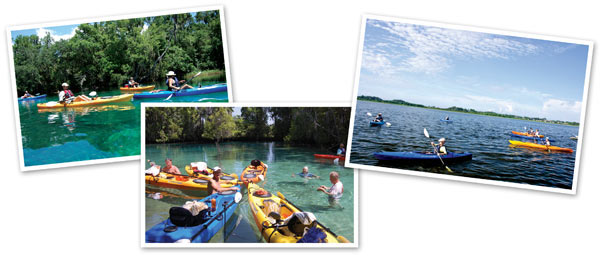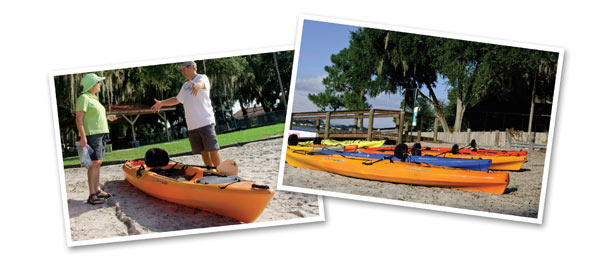
The best way to experience real Florida is by gliding along the pristine rivers, springs, lakes and coastline aboard a kayak. Just be sure to get the proper introduction to safety and paddling skills before embarking on a scenic journey through the state’s many waterways.
By Mary Ann DeSantis
My first experience on a kayak was not the adventure I had envisioned. It was a hurried event on a spring night in Puerto Rico to see the famous bioluminescent lagoon at Fajardo. The hotel tour operators placed a group of us in kayaks with no training. “How hard could it be?” I thought as I slipped into the seat of a tandem sea kayak behind my husband. Let’s just say it was much more difficult than either of us expected. Paddling through the dark mangroves at night became a harrowing experience, especially as we tried to keep up with the more experienced kayakers and maneuver our way through low-hanging branches and around other paddling neophytes.
Visiting Florida’s many beautiful state parks and trails sparked my desire to try kayaking again, albeit five years later. This time, however, I was determined to get proper training on how to handle such a vessel.
“A lot of people who had bad experiences in a canoe or kayak won’t try it again,” says Kevin Mims, adventure insider for VisitFlorida.com and an avid kayaker himself. “But kayaking takes you to places you can’t get to any other way.”
Kayaking is an often-requested activity among visitors planning trips to the Sunshine State. A 2011 outdoor recreation survey by the Florida Department of Environmental Protection’s Recreation and Parks Division showed that wildlife viewing ranked only slightly lower than beach activities in popularity for both tourists and residents. Surprisingly, more people wanted to view wildlife than catch fish.
“And kayaking is the best way to view wildlife,” says Kevin. “You are definitely immersed in the natural side of Florida.”

Kayaks and canoes have been around for centuries. Early Aleuts and Eskimos in the Arctic were among the first to use kayaks for hunting. In fact, the word ‘kayak’ literally means “hunter’s boat.” The slim vessels, first made of seal skins and whalebones or wood, were perfect for quietly sneaking up on prey. Today, nature lovers find kayaks to be ideal for watching Florida’s menagerie of wildlife for the same reason. Kayaks glide quietly toward areas where shore birds, alligators and other species go about their business unaware that they are being watched and enjoyed.
While everyone sooner or later asks about alligators, Kevin says that the reptiles are not the biggest safety issue.
“The simple safety issues are far more important, like always wearing a Personal Flotation Device (PFD) life jacket,” he says. “Almost every Florida waterway has a gator, but they usually are not aggressive. Just let them swim by and they’ll leave you alone.”
Although men were the first to use kayaks, a growing number of women are grabbing paddles and heading to the water. According to Road & Travel Magazine, kayaking is among the fastest growing travel trends for women. Of the nearly 8 million active kayakers in the United States, more than 45 percent are women, says the National Sporting Goods Association (nsga.org). In fact, it was my kayaking girlfriends who convinced me to try the sport again, leading me to Ryan Toler of Ocala’s Discovery Kayak Tours.
Ryan, a Lady Lake native, earned a bachelor’s degree in environmental studies and outdoor recreation from North Carolina’s Montreat College. After working as an educator and naturalist, he began Discovery Kayak Tours nearly five years ago as a way to turn his passion for the outdoors into a sustainable business. And he’s found a niche market with active retirees and baby boomers like me.
“We furnish everything you need to have: an easy paddle and comfortable ride,” says Ryan. “The majority of the people in our ‘Kayak Krew’ paddle club are seniors who do not want to haul kayaks to and from home. We even take the kayaks to the water’s edge for them.”
His two-hour “quick-start” classes cover every aspect of kayaking from safety and proper gear to paddling techniques. By the second hour of class, students are on the water going through simple paddling maneuvers with Ryan and his expert guides. Some students need one-on-one help—again like me—and Ryan and his assistants make sure everyone is comfortable and confident on the water. His patience and relaxed demeanor pay off because more than 90 percent of his students regularly return to participate in his kayak tours along the Silver River, Rainbow River, Three Sisters Springs and other locations.
Ray and Cindy Wittich of The Villages were in Ryan’s very first kayaking class at Lake Miona in 2008 and now tour with him five or six times a year.
“We wanted to kayak, but the club in The Villages was not taking new members,” says Ray. “With Ryan, it turned out so much better. He’s a great story teller, and he talks about wildlife and the history of the areas where we paddle.”
Retiree Vicki Cox agrees. She took Ryan’s class two years ago and has been on several of his tours. She and a friend visited Sarasota recently where they signed up to tour mangroves by kayak.
“We thought the guides would tell us about the area the way Ryan does,” she says. “They handed us a water map and told us to use our cell phones to call when we returned to the shore. It was not like Ryan who points out everything during a tour.”
Ryan’s attention to detail, as well as his satisfied students, inspired me to pick up a paddle and join the group—this time in daylight and on the calm waters of Sumter County’s Lake Miona, where Discovery Kayak’s quick-start classes are usually held. The morning began with a safety overview, paddling instructions and an explanation of the different kinds of kayaks. Ryan and I would use lightweight recreational kayaks, while his assistant, Tony Fekete, would be nearby in his bright yellow sea kayak.

Sea kayaks are longer (about 16 feet) than recreational kayaks that range from 10 to 14 feet in length. Sea kayaks are less stable but much faster—something I assumed would come in handy if Tony had to get to me quickly should I somehow drift across the lake.
Once I learned how to properly get into the kayak’s sit-on-top seat (sit down sideways and turn to the front), we paddled just offshore where Ryan put me through a series of maneuvers to make sure I could turn the kayak in the direction I wanted it to go. I also had to think whether to paddle more on my left side or my right when I had to guide my kayak toward Ryan’s so that the bows would “kiss” gently.
“Sometimes folks forget their left and right on the water, but so far, you are doing pretty well,” he said with a smile as my kayak touched the front of his.
Before the second hour of class was finished, I was cruising around the lake as if I’d been kayaking all my life. A few days later, I was already planning my next paddling adventure and convincing friends they needed to take up kayaking, too. The Puerto Rican adventure was a distant memory, and proper training was now going to let me see Florida like I’d never seen it before.
Want to know more?
dep.state.fl.us (then search paddling)






